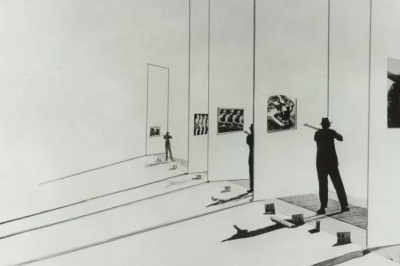
THESE SOCKS NOT WHITE (DEZE SOKKEN NIET WIT)
the 1920s - the collection in context
curated by Bik Van der Pol
Van Abbe Museum, Eindhoven
2012
image: László Moholy-Nagy – The Shooting Gallery, 1925-27These socks not white (Deze sokken niet wit)
These Socks Not White shows artworks from the collection of the Van Abbe museum alongside texts, non-art objects and visual material from the archives of the International Institute of Social History (IISG) in Amsterdam, as well as films from the period. An additional walking route will take visitors through parts of Eindhoven passing by contemporaneous buildings including churches, apartments, a bridge, de Witte Dame, and the former Philips factories at Strijp-S.
The world we live in today - and especially Europe, the part of the world we think we know so well - is changing rapidly. The transformation of social democracy to global, neoliberal capitalism and the resulting swathes of privatisation has lead to a loss of public space in the broadest sense. The present crisis is reminiscent of the period 1924-1929. These Socks Not White does not aim to prove that then and now are the same. Rather, by using the collection of the museum as working capital, it seeks to investigate links with our current time and to speculate about our experiences in society today and the direction in which we are heading.
These Socks Not White concentrates on the period 1924-1929, but expands outwards because the spirit of the age never stands still. This time -the roaring twenties- was a time of paradoxes and extremes. The Weimar Republic reached its high peak followed by extreme bouts of inflation.
There was great innovation and prosperity, as well as increasing cultural conflicts and social polarization, resulting in confusion, fear and nationalism. It was a time of great social, scientific and philosophical breakthroughs, including the emancipation and women's suffrage, the invention of radio, television and film; media were booming like never before. Yet at the same time dangerous trends were forming: extreme fundamentalism, euphoric speculation and consumerism combined with mass unemployment, banking crises, overheated stock markets and ultimately the Wall Street crash of 1929.
The title of the exhibition - These Socks Not White- is derived from a Dada document addressed to the "HH Journalists and Editors". This pamphlet was prepared in response to the fierce criticism Van Doesburg and his associates received after the 'Dada Campaign', and says - jokingly - that the socks that Theo van Doesburg wore during the Dada soirees were not white, but 'gris-perle’. Not everything is/should be what it looks like, the pamphlet seems to say. The image created by the media does not always convey reality. What way is information generated, what is deemed important and why, what is chosen to create an image of past and present? If we think we know what we believe we know, do we see it as well, even if it is not directly said or shown, that way?